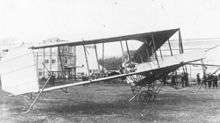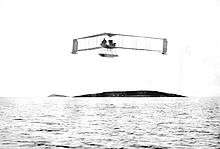Dunne D.8
The Dunne D.8 of 1912 was a tailless swept wing biplane, designed by J. W. Dunne to have inherent stability. One example was supplied to RAE Farnborough. License-built Burgess-Dunne models were used by the US Signal Corps and United States Navy and the short-lived Canadian Aviation Corps. It was the latter's first and only warplane.
| D.8 | |
|---|---|
 | |
| Dunne D.8 at Farnborough, 11 March 1914 | |
| Role | Experimental aircraft |
| National origin | United Kingdom |
| Manufacturer | Blair-Atholl Syndicate Ltd, London |
| Designer | J. W. Dunne |
| First flight | June 1912 |
| Primary users | Capt. A. D. Carden Nieuport United States Navy |
| Number built | 4 |
| Developed from | Dunne D.5 |
Design and development
J. W. Dunne's first swept biplane wing aircraft, designed to have automatic stability, dated from his employment at the Army Balloon Factory (later RAE Farnborough) during 1906–09. After leaving Farnborough, Dunne set up a private company, the Blair Atholl Aeroplane Syndicate Ltd. Its first aircraft was the Dunne D.5.[1][2] When this crashed in 1911 it was rebuilt as the D.8.[3] The two models shared very similar wings and the same engine, but the D.8 had a single pusher propeller instead of the chain-driven pair of the D.5. Their fuselages and undercarriages were also different.
The D.8 was a tailless four bay unstaggered biplane with its wings swept at 32°. Its constant chord wings were built up around two spruce spars, the forward one forming the leading edge. To help achieve stability the incidence and interplane gap decreased outboard, the former becoming negative. This washout on tips well behind the centre of gravity provided longitudinal stability in the same way as a conventional tailplane, set at lower incidence than the wings. Camber increased outwards. Simple, near parallel, pairs of interplane struts joined the spars. The outer interplane struts were enclosed with fabric, forming fixed side curtains that provided directional (yaw) stability. Wing tip elevons were used for control, operated by a pair of levers, one either side of the pilot. The D.8 initially used just a pair of these, mounted on the upper wing, a rectangular cutout in the side curtains allowing for their movement as on the D.5.[2] Large parts of the aircraft were built by Short Brothers.[4]
The D.8's water-cooled 4-cylinder, 60 hp (45 kW) Green engine directly drove a single pusher propeller, saving weight compared with the D.5's chain drive.[3] As a consequence of the propeller position the fuselage was shortened at the rear; it was also extended in the nose. This first D.8 seems to have been a single-seater like its D.5 predecessor,[1] the pilot sitting at mid chord.
The undercarriage was complex, comprising a narrow-track pair of sprung wheels with wingtip skids. It featured undamped, opposing springing and an elaborate anti-noseover skid.[5]
The Green engine was later replaced by an 80 hp (60 kW) 7-cylinder Gnome rotary engine.[3] This engine also powered the second aircraft, which was a two-seater with the pilot placed just ahead of the wing leading edge and the passenger (who had dual control) at the trailing edge.[5] There were now control surfaces on both upper and lower wings, the side curtains having a pair of tapered notches to allow them to move. Each of the upper wings carried a pair of elevons, nearly doubling the control surface area.[5]
History
The D.8 first flew in June 1912 at Eastchurch, fitted with a Green engine. It was present at the Larkhill Military trial in August 1912, though it did not take part in the competition.[3] Despite the two handed arrangement of the D.8's controls, the one-handed Capt. A.D. Carden gained his Royal Aero Club Aviator's Certificate on it in June 1912.[6]
In 1913 the D.8 was fitted with an 80 hp Gnome engine which greatly improved performance and reliability. 1913.[3] In August 1913 Commandant Felix piloted a D.8 across the English Channel from Eastchurch to Villacoublay, Paris. Nieuport had obtained a licence to build the D.8 and Felix gave demonstration flights in France on their behalf.[6]
A Nieuport-built Dunne appeared at the Paris Aero Salon in December 1913. Like the second D.8 it was a Gnome powered two-seater, but with significant differences both aerodynamically and structurally. It combined the double upper wing elevons into a single surface and had very rounded rear wingtips.[7] The fuselage was slightly modified and built around steel tubes rather than wood. The interplane struts were streamlined steel tubes. It also had a strikingly simplified undercarriage.[8]

Dunne had obtained a War Office order for two D.8s, though one was cancelled because of late delivery. The other was delivered to Farnborough on 3 March 1914, where it was given the RFC number 366.[3] It made several flights on 11 March piloted by N. S. Percival, who had flown the first D.8 many times at Eastchurch and was now an RFC officer. The general judgement was that in the search for balance between stability and controllability, the Dunne design overemphasised the former.
Variants
- Nieuport-Dunne A modified D.8 built under license by the French Nieuport company and exhibited at the Paris Salon in 1913.[9]
- Burgess-Dunne The Burgess Company and Curtiss, based in Marblehead, Mass, USA gained the US manufacturing rights and built a series of aircraft based on the D.8. They became known as Burgess-Dunne machines and were mostly single-float planes. The first flew in March 1914,[10] piloted by Clifford Webster. Apart from wingtip floats the wings were identical to those of the D8, but the fuselage was revised with a distinct nacelle containing a more enclosed cockpit. The aircraft was a single-seater, with the heavier 100 hp (75 kW) Curtiss OXX2 water-cooled engine moved forwards, shortening the fuselage and with its radiator placed between engine and pilot. The single float was 17 ft 8 in (5.38 m) long, shallow and flat bottomed viewed from in front, with a single step. The prototype behaved well in the air and on the water.[11] The second machine was very similar to the first, but room was made for a second seat by replacing the single fuselage mounted radiator with a pair fixed to the rear float struts.[10]
- The second machine was bought by the Canadian government for the Canadian Aviation Corps and was their first military aircraft. It was shipped to Europe on the SS Athenia for service in World War I, but was seriously damaged in transit and not used.[12] The third machine, another two-seater but powered[13] by a Salmson M-9 radial providing 135 hp (101 kW), was delivered to the US Signal Corps in either 1914 or 1915.[14] Two were also delivered to the US Navy[15] as type AH-7, fitted with a 90 hp (67 kW) Curtiss engine[13] and AH-10 with the 100 hp Curtiss. The latter set a US altitude record of 10,000 fft (3,050 m) on 23 April 1915.[13] One Burgess-Dunne was configured as a landplane for a time.[16][17]

- The Burgess-Dunne types were[6]
- BDI - as the prototype.
- BD - as the second aircraft, first aimed at the military market then as a sports plane.[13]
- BDH - a two-seater with a 140 hp (100 kW) Sturtevant V-8 engine[13] and a slightly increased span (46 ft; 14 m).
- BDF - a three-seat, flying boat variant with the Curtiss engine but a span increased to 53 ft (16 m).
- A full scale, non-flying replica of a Burgess-Dunne is displayed in the RCAF Memorial Museum, CFB Trenton, Ontario,[18] largely built by Barry D. MacKeracher.
- D.10 A development built around 1912 with a modified wing, which proved a failure and was converted back to a D.8.[19]
Specifications (second aircraft)
Data from Bruce 1992
General characteristics
- Crew: 1
- Wingspan: 46 ft 0 in (14.02 m)
- Wing area: 545 sq ft (50.6 m2)
- Empty weight: 1,400 lb (635 kg)
- Gross weight: 1,900 lb (862 kg)
- Powerplant: 1 × Gnome 7-cylinder rotary, 80 hp (60 kW)
Performance
- Maximum speed: 56 mph (90 km/h, 49 kn)
- Rate of climb: 500 ft/min (2.5 m/s)
References
Notes
- "The Dunne Aeroplane". Flight. 18 June 1910. pp. 459–462.
- Flight 25 June 1910 pp.477–481
- Bruce 1992
- Barnes & James 1989, p. 506
- Flight 15 September 1913 pp.1241–5
- Lewis 1962, pp. 228–229
- Flight 13 December 1913 p.1328
- Flight 3 January 1914 p.7
- Flight, 13 December 1913, pages 1348-9.
- Flight 25 June 1914 pp.644–647
- Flight 2 May 1914 p.476
- "Cargo damaged in transit 1914". vintageairphotos.blogspot.co.uk. Retrieved 5 October 2017.
- Aerofiles
- Fahey 1946, p. 6
- Aviation Pioneers
- E. Jones Aeronautical Collection
- Boston Evening Transit 18 July 1914
- Burgess-Dunne replica
- Lewis (1962), p.229.
Bibliography
- Barnes, C.H.; James, D. N. (1989). Shorts Aircraft since 1900. London: Putnam Publishing. ISBN 0-87021-662-7.CS1 maint: ref=harv (link)
- Bruce, J.M. (1992). The Aeroplanes of the Royal Flying Corps (2nd ed.). London: Putnam Publishing. pp. 221–223. ISBN 0-85177-854-2.CS1 maint: ref=harv (link)
- Fahey, James C. (1946). US Army Aircraft. New York: Ships & Aircraft Ltd.CS1 maint: ref=harv (link)
- Lewis, Peter (1962). British Aircraft 1809-1914. London: Putnam Publishing.CS1 maint: ref=harv (link)
External links
![]()